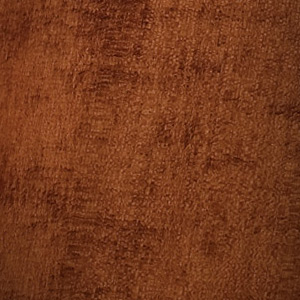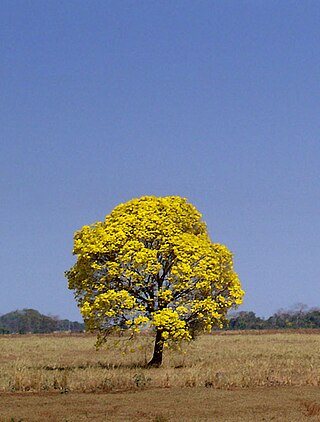
Wood is a structural tissue/material found as xylem in the stems and roots of trees and other woody plants. It is an organic material – a natural composite of cellulosic fibers that are strong in tension and embedded in a matrix of lignin that resists compression. Wood is sometimes defined as only the secondary xylem in the stems of trees, or more broadly to include the same type of tissue elsewhere, such as in the roots of trees or shrubs. In a living tree, it performs a mechanical-support function, enabling woody plants to grow large or to stand up by themselves. It also conveys water and nutrients among the leaves, other growing tissues, and the roots. Wood may also refer to other plant materials with comparable properties, and to material engineered from wood, woodchips, or fibers.

Tamarind is a leguminous tree bearing edible fruit that is indigenous to tropical Africa and naturalized in Asia. The genus Tamarindus is monotypic, meaning that it contains only this species. It belongs to the family Fabaceae.

The French West Indies or French Antilles are the parts of France located in the Antilles islands of the Caribbean:

Wood easily degrades without sufficient preservation. Apart from structural wood preservation measures, there are a number of different chemical preservatives and processes that can extend the life of wood, timber, and their associated products, including engineered wood. These generally increase the durability and resistance from being destroyed by insects or fungi.

Antillean Creole is a French-based creole that is primarily spoken in the Lesser Antilles. Its grammar and vocabulary include elements of French, Carib, English, and African languages.

Calophyllum is a genus of tropical flowering plants in the family Calophyllaceae. They are mainly distributed in Asia, with some species in Africa, the Americas, Australasia, and the Pacific Islands.

Terminalia elliptica is a species of Terminalia native to southern and southeast Asia in India, Nepal, Bangladesh, Myanmar, Thailand, Laos, Cambodia, and Vietnam. It is a prominent part of both dry and moist deciduous forests in southern India up to 1000 m.

Acacia melanoxylon, commonly known as the Australian blackwood, is an Acacia species native to south-eastern Australia. The species is also known as blackwood, hickory, mudgerabah, Tasmanian blackwood, or blackwood acacia. The tree belongs to the Plurinerves section of Acacia and is one of the most wide-ranging tree species in eastern Australia and is quite variable mostly in the size and shape of the phyllodes.

Astronium graveolens is a species of flowering tree in the cashew family, Anacardiaceae, that is native to Mexico, Central America, and South America as far south as Bolivia. Common names include glassywood, ronrón (Spanish), and aroeira (Portuguese). This plant is cited in Flora Brasiliensis by Carl Friedrich Philipp von Martius.

A wood-decay or xylophagous fungus is any species of fungus that digests moist wood, causing it to rot. Some species of wood-decay fungi attack dead wood, such as brown rot, and some, such as Armillaria, are parasitic and colonize living trees. Excessive moisture above the fibre saturation point in wood is required for fungal colonization and proliferation. In nature, this process causes the breakdown of complex molecules and leads to the return of nutrients to the soil. Wood-decay fungi consume wood in various ways; for example, some attack the carbohydrates in wood, and some others decay lignin. The rate of decay of wooden materials in various climates can be estimated by empirical models.

Dalbergia sissoo, known commonly as North Indian rosewood or shisham, is a fast-growing, hardy, deciduous rosewood tree native to the Indian subcontinent and southern Iran. D. sissoo is a large, crooked tree with long, leathery leaves and whitish or pink flowers.

Microberlinia bisulcata is a species of plant in the family Fabaceae, a lowland rainforest tree that is found only in Cameroon. It is threatened by habitat destruction and exploitation. Common names include African zebrawood, tigerwood, zebrano and zingana.

Eusideroxylon is a genus of evergreen trees of the family Lauraceae. The genus is monotypic, and includes one accepted species, Eusideroxylon zwageri. It is known colloquially in English as Bornean ironwood, billian, or ulin.
Guijo is a species of plant in the family Dipterocarpaceae. It is a tree found in Cambodia, Laos, Vietnam, Sumatra, Peninsular Malaysia, Borneo and the Philippines. The name guijo is a Philippine Spanish word derived from the Tagalog gihò. This is also sometimes known as red balan or red balau sharing its name with Shorea balangeran. Other local names include yamban-yamban in Zambales and taralai in Tarlac.
Terminalia ivorensis is a species of tree in the family Combretaceae, and is known by the common names of Ivory Coast almond, idigbo, black afara, framire and emeri.

Nato wood is a general term for wood from Mora trees. The best-known species are Mora excelsa (mora) and Mora gonggrijpii (morabukea). This should not be confused with nyatoh, an Asian hardwood from the family Sapotaceae with a very similar look and characteristics to Honduras mahogany, though totally unrelated.

George Brindsley McSween, known as Sir Galba, was a Grenada-born calypso singer and recording artist in the 1940s and 1950s.

Guazuma ulmifolia, commonly known as West Indian elm or bay cedar, is a medium-sized tree normally found in pastures and disturbed forests. This flowering plant from the family Malvaceae grows up to 30m in height and 30–40 cm in diameter. It is widely found in areas such as the Caribbean, South America, Central America and Mexico serving several uses that vary from its value in carpentry to its utility in medicine.

Handroanthus is a genus of flowering plants in the family Bignoniaceae. It consists of 30 species of trees, known in Latin America by the common names poui, pau d'arco, or ipê. The latter sometimes appears as epay or simply ipe (unaccented) in English. The large timber species are sometimes called lapacho or guayacan, but these names are more properly applied to the species Handroanthus lapacho and Handroanthus guayacan, respectively.
Ocotea porphyria is a species of evergreen tree in the laurel family (Lauraceae). It is native to southern Bolivia and northwestern Argentina, where it lives in humid montane forests, or Yungas, on the eastern side of the Andes. Common names include laurel del cerro, laurel la falda, laurel tucumano, and ayuínandí.


















